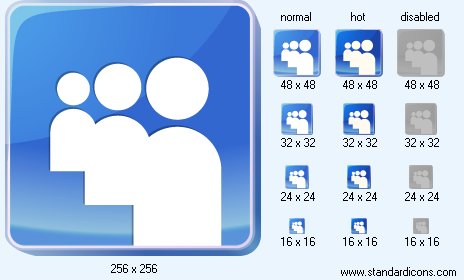


|
| ||||||||
|
|
MySpace Icon |
|
Icon sizes: 512x512, 256x256, 48x48, 32x32, 24x24, 16x16
File formats: ICO, GIF, PNG, BMP
Choosing The Right Image File Format When Making Graphics.
There are numerous image file formats that can be put to use for saving web graphics and for a newbie web creator this can quickly change into a big issue because you will need to understand how to use a particular file format, here is a an explanation of the benefits and drawbacks of some popular file formats.If you find yourself drawn to icon making or wish to create graphical representations for your web page, it is imperative to learn about the varied image formats and their attributes so that you can utilize the appropriate file type for an image. Some of the commonly used file formats for images are PNG, GIF and JPEG, all of these file formats has its own traits so lets talk about the pros and cons of utilizing these formats, the type of image format that will suit your website and optimizing your images for the web.
GIF: It is the abbreviation for Graphics Interchange Format; the format is one of the most commonly used file types. The image format is well accepted because of its small size which makes uploading a breeze. Unlike JPEG, details are not lost in this image format ; this equates to the fact that you can save the graphic at just a few bytes and without compromising the quality of the picture. GIF offers transparency support in pictures, it is the most commonly used file formats for icon creation. Unlike the other file types, animation is also possible in GIF. If you wish to optimize a GIF file, it is necessary to restrict the size of the file; it would be best that you choose a 32 color palette to get the smallest possible size.
JPEG: This is short for Joint Photographic Experts Group; the image format is commonly called JPG and is frequently incorporated for online graphics. One of the main benefits of utilizing this type of file is that you can save the graphics in true color that affords you as many as 16 million colors; this makes the file format suitable for use with photographs and pictures that boast of vast color range. One of the cons of using JPG is the data loss that is encountered each time the image is stored; this points to the fact that the image is prone to clarity issues and some details may be lost. Unlike other file formats such as GIF, transparency support is not offered in this format. If you have chosen a superior image editing software such as the Adobe Photoshop, you can choose the image quality and the size of the JPG file ; however, it is vital to understand that the lower the resolution the smaller the size, which is convenient to upload.
PNG: Is an abbreviation for Portable Network Graphics and is a very fresh file format. PNG is available in two versions types; PNG-8 which offers 8 bit color format and the PNG-24 which has 24 color images. PNG-8 can curtail the size images with great detail and without the normal loss of information seen in GIF files; this leads to better image quality and quick uploads. But, PNG-24 is not as effective as JPG when you have to store photos and other images that need a wider color range. The image format is loss-less; this means that the image retains its quality and clarity. PNG-24 offers transparency support and you can include varying degrees of the transparency feature in this format. When you use this file format the images are professional looking because they do not have the tell tale jagged edges when inserted on a contrasting color backgrounds like GIF files.
Copyright © 2009-2022 Aha-Soft. All rights reserved.
|
